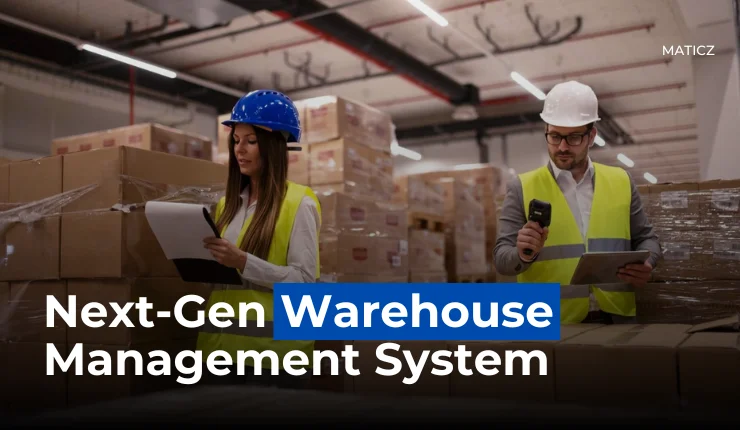Share Posts

Warehouse Management System
46
2781
103
What is a Warehouse Management System?
A warehouse management system is a software solution that allows companies to manage and optimize all their warehouse processes. This software is widely used in retail, e-commerce, and manufacturing industries to keep track of goods and materials right from their entry to exit in the warehouse. It streamlines and monitors every aspect of warehouse management from merchandise entering the warehouse, picking and packing onto shelves, until the moment they leave for order fulfillment.
This helps companies optimize their space utilization, resource usage, and material flows. Being equipped with innovative tools including RFID labeling, bar code scanning, shipment tracking, ERP, and more, warehouse management systems organize all of the warehouse activities from a single interface. This software is designed to speed up product deliveries, reduce distribution delays, and save money.
Why Build Warehouse Management Software?
In today's dynamic economy, the demand for warehouse management systems is going to witness a sharp rise due to rapidly changing consumer needs. Especially industries like e-commerce rely heavily on fulfillment facilities like warehousing and shipping for effective order picking, packing, processing, and delivery.
In 2023, the global warehouse management system market size reached USD 3.07 billion. This value is predicted to attain USD 9.11 billion with a CAGR of 12.9% by 2032. This shows how the warehouse management system market is experiencing significant growth and transformation.
As per another study, 80% of organizations within the warehousing, logistics, and retail sectors are planning to invest in new technologies. They think this strategic move could help them stay competitive in a dynamic market.
According to a recent survey, 67% of respondents reported losing customers due to errors that resulted in overselling or being out of stock after an order was placed. This highlights the necessity for reliable and efficient warehouse management systems.
Building a Warehouse Management System is a smart business investment. There are many reasons why one should consider investing in WMS software. When you invest in a WMS, you can have a quick and positive impact on your bottom line and reduce operating costs, providing an excellent return on investment.
Types Of Warehouse Management Systems
There are many types of warehouse management systems (WMS), and each comes with its advantages and disadvantages. It is quite challenging to specify the best one since it may differ from business to business. These systems differ in the integration capabilities and features they offer. Understanding the differences between these types and choosing the one that suits your business size and operational requirements well is essential.
Standalone WMS
Standalone warehouse management systems focus mainly on controlling inventory, managing labor, and handling orders. They are suitable for small and medium-sized businesses with limited software budgets. The reason why most businesses go for standalone systems is because they can deliver focused warehouse management without much integration with other systems.
- Cost-efficient
- Straightforward to implement
- Specialized features for warehouse operations
Supply Chain Modules
When you choose this type of warehouse management system, you get a supply chain management application with warehousing features. It offers a comprehensive solution to handle warehouse operations within the broader supply chain. It is ideal for businesses looking for seamless data sharing and real-time visibility into warehouse operations as well as supply chain processes.
- Optimize inventory management
- Streamlined shipping process
- Improved order fulfillment
ERP Integrated WMS
Yet another type of warehouse management system is to build it as applications or modules that integrate with ERP. It provides a holistic view across the business and is not confined to warehouse operations rather offers a centralized platform to manage inventory, reduce stockouts, and other business processes.
- Seamless integration
- Effortless data sharing
- Efficient operations
Cloud-Based WMS
Cloud-based WMS offers remote accessibility so that users can manage their warehouse operations from anywhere and anytime. It is highly cost-effective that companies need to pay only based on usage. What sets this type of warehouse management system apart is the scalability and flexibility it provides to support changing market conditions.
- Robust security
- High scalability
- Better connectivity
Features of Warehouse Management System
While choosing the warehouse management system, it is important to ensure all the functional requirements and capabilities you need are present in it. Here is a list of features you need to look for in a WMS to transform your operations and boost your bottom line.
Advanced Forecasting Tools
The warehouse management system is incorporated with advanced forecasting tools that use historical data and predictive analytics to predict future demand allowing companies to keep just the right amount of stock on hand.
User-Friendly Interface
An intuitive and accessible interface of the warehouse management system makes it simple for employees to easily navigate the system and execute operations efficiently. This results in more productive and accurate operations, minimizing errors.
Integration Capabilities
The warehouse management system is designed in a way that it is easy to integrate it with other systems such as Enterprise Resource Planning (ERP), Fleet Management Systems, and more. This helps combine different systems and perform various business functions in a single platform.
RFID or Barcode Scanning
In warehouse management, most of the time is spent on counting items manually which can also lead to more errors. But with RFID or barcode scanning feature, it is easy to scan and trace items in the warehouse more quickly and accurately.
Batch and Serial Number Tracking
Batch and serial number tracking help track unique batch or serial numbers of items and collect information such as their origin, condition, time frame, and manufacture dates, enhancing traceability.
Reporting and Analytics
The reporting and analytics feature of the warehouse management system offers various operational data reports on inventory, labor, space, order, and KPI that help warehouse managers track their performance and identify areas of improvement.
Warehouse Location Management
Warehouse location management helps find and arrange the space in the warehouse. Be it bulk storage, pick faces, or controlled storage, it identifies unique location IDs across various warehouse zones.
Inventory Tracking
Inventory tracking helps in inventory management, offering a detailed view of stock levels such as what items are in stock, where are they, and what quantity. This helps control order fulfillment, and reduce the risk of having too much or too little stock.
Order Management
A warehouse management system (WMS) optimizes the entire order and fulfillment process, regulating the flow of products through the warehouse. Workers no longer need to run back and forth for shipping operations.
Receiving and Storage
Receiving and storage is a non-negotiable feature in the warehouse management system. This feature helps check the differences between the purchase order and the actual items received. Based on the type of items received, it assigns the storage space.
Shipping Management
Shipping management includes automated courier and service selection. Based on the order details and destination, it helps generate required documents, receipts, and shipping labels with accurate information.
Picking and Packing Goods
Warehouse management systems follow different pick and pack processes depending on the types of items being handled. It helps pick multiple orders, check for damaged or missing items, and prepare papers like despatch notes, packing lists, and more.
Returns Management
Another important feature of the warehouse management system is returns management which facilitates the return of items against an order or blind receipt. It helps record the details and condition of returned items and ask for an exchange or refund.
Yard and Dock Management
Yard and dock management in the warehouse management system offers real-time visibility into the vehicle and goods movement within the warehouse. It helps in yard driver task optimization and dock scheduling for increased efficiency and cost savings.
Benefits of Warehouse Management System
Warehouse Management Systems (WMS) equipped with innovative tools and features offer a multitude of benefits right from improving operations to saving money. Let's take a look at them.
Improved Operational Efficiency
The warehouse management system automates and streamlines various warehouse processes such as inventory tracking, order picking, and shipping. It not only improves the capacity to handle larger volumes but also reduces errors in picking and shipping goods.
Cost Saving
Instead of wasting money on ineffective warehouse management, businesses can go for scalable WMS solutions. Especially its cloud-based options are especially highly cost-effective and help grow your warehousing business cutting down on additional expenses.
Faster Inventory Turnover
The warehouse management system offers total control and visibility of your inventory, right from receiving and shipping. It helps avoid reduced cash flow due to overstocks and backorders because of stockouts, creating a faster inventory turnover.
Better Labor Allocation and Productivity
With a warehouse management system, it is now easy to allocate tasks based on workforce availability and skill levels. Utilizing modern and automated systems like WMS can optimize various warehouse operations, leading to increased labor productivity.
Improved Stock Control
WMS streamlines the complex stock processes where stocks are constantly on the move. It keeps track of each of the product's whereabouts whether it is coming in, being stored, or going out. It also recommends items to be stocked based on their quick turnover.
Optimized Warehouse Space
A warehouse management system helps organize the layout of the warehouse to make the best use of available space, enabling it to store a larger volume of goods and items. Also, it reduces the time spent on sorting spaces and increases storage capacity.
Technologies Used In Warehouse Management Software
Warehouse technologies help transform various warehouse processes such as storing, receiving, picking, and packing. We have explored the best wearable technologies to be implemented in your warehouse operations to boost productivity and efficiency. Get a glimpse of them.
Automated Picking Tools
Automated picking tools help identify and pick the right Stock Keeping Units (SKU) in the correct quantities for each order. It utilizes tools such as pick-to-light systems, automated picking robots, and voice-picking tools to minimize picking errors and boost accuracy across your warehouse.
Warehouse Drones
Warehouse drones are aerial robotics platforms, equipped with cameras and sensors to help collect inventory data in the warehouse. They can be manually controlled as well as programmed to operate automatically based on the specific requirements of the task.
3D Bin Packing
3D bin packing technology refers to an algorithmic approach to packing items of various sizes and shapes into three-dimensional boxes or bins. It is used to automate the packing process and maximize space utilization. Being widely used in warehouse management, it not only frees up space but also reduces the cost spent on packaging.
Automated Document Insertion
Manually placing documents can be a time-consuming and error-prone process. Automated document insertion uses programmed systems to put documents such as invoices, packing slips, return forms, and more into packages. It helps place the correct document on its package, according to its order number or information.
Automated Storage and Retrieval Systems (ASRS)
Automated Storage and Retrieval Systems (ASRS) are computer-controlled systems that work automatically to store, organize, and retrieve goods in the warehouse. It contains various equipment like mini-loaders, unit-loaders, vertical lift modules, tote shuffles, and horizontal carousels that operate well even in warehouses with high ceilings and horizontal carousels.
Automated Guided Vehicle (AGV)
Automated Guided Vehicles (AGV) are automated robots that help move items within the warehouse between two points. They use sensors, wires, and reflective markers to move goods and materials along pre-designed paths without human supervision. Being equipped with GPS, helps the vehicle reach the exact location where it needs to pick up.
What Makes Us the Best Warehouse Management Software Development Company?
Many businesses have started to adopt a Warehouse Management System (WMS) to stay competitive. Especially the boom in online shopping and the pandemic have pushed many companies to invest in WMS. The adoption of Warehouse management systems is happening at a rapid pace due to technological advancements and the need to meet evolving consumer demands. Now it’s your time to implement WMS to transform your business and remain competitive.
Maticz is a leading warehouse management software development company that helps businesses across the globe with our highly-equipped warehouse management systems. We offer futuristic warehouse solutions to help companies optimize their distinct warehouse operations. Then why wait? Collaborate with us today to get better business results.
Tap Into the Future
The latest insights, posts, and project updates - straight to your inbox.




